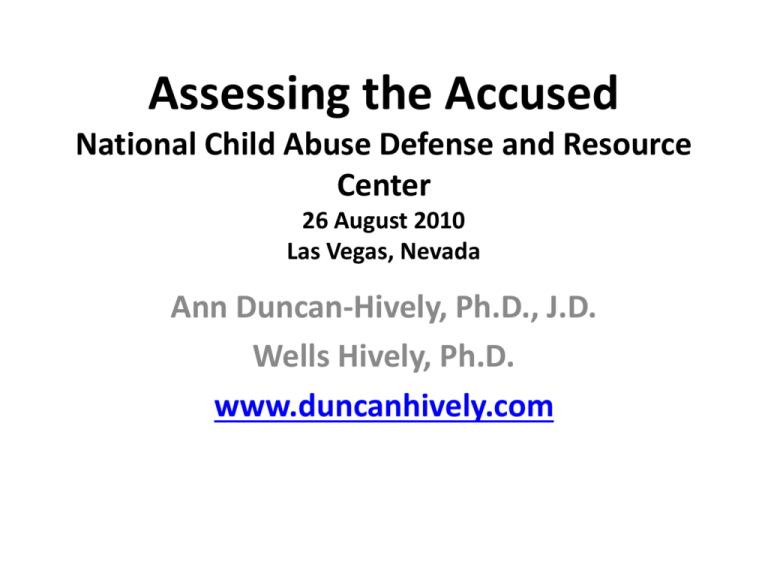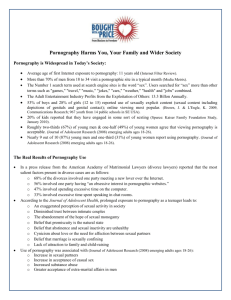
Assessing the Accused
National Child Abuse Defense and Resource
Center
26 August 2010
Las Vegas, Nevada
Ann Duncan-Hively, Ph.D., J.D.
Wells Hively, Ph.D.
www.duncanhively.com
What?, Why? Who Should Do It?,
When?
•Systematic, objective description of
psychological functioning of the accused
•To assist the attorney in decision making
prior to conversation with prosecutor
•Must use an expert who meets the
Daubert standards
•As early in the case as possible
Who Are the Accused?
According to Defense attorney: People
According to the Prosecutor: Profiles
• Defense’s Assessment: An individual portrait
in a distinctive family and community setting
– In search of alternate explanations, motivations
and misunderstandings
• Prosecution’s Assessment: A description of
how the individual fits a typical offender
profile
– In search of a convincing label and “method of
operation”
• Why prosecutors like profiles
– “Botanizing” the offenders makes prosecution of
the accused convenient and righteous
– Profiles are compelling for jury and judge
• What the defense can do
– Use your own psychological assessment of
defendant to blow holes in prosecutor’s
assumptions
and/or
– Use it to provide prosecutor with accurate
information that can contribute to plea bargain
or mitigation at sentencing
Child Molesters From the Prosecutor’s
Viewpoint
Ken Lanning, FBI SSA (Ret.)
“Child Molesters: A Behavioral Analysis,” 2010
download from
http://www.missingkids.com
• One man’s logical analysis, based on FBI Behavioral
Analysis Unit experience
• Comprehensive and complicated
• Reference point for most prosecutors
• Prosecutors use it as:
– Guide to investigation
– Guide to arguing the case to the jury
Situational-Impulsive
Rarely plans or collects
souvenirs
Situational- Impulsive
•
Regressed: low self esteem, poor coping
ability, stressed,
•
Morally Indiscriminate: Impulsive, no
conscience
•
Inadequate: Handicapped, not understand
the norms, “exploring sexual interests.”
• Preferential-Compulsive
• Always collects souvenirs
•
•
•
•
Preferential – Compulsive
Seductive: groom their targeted victims
Inadequate: hang around playground
Sadistic: aroused by pain
Diverse: “try-sexual”
Sociopaths
A special case
Child Pornography
Should Point and Click be an Offense?
Increasing numbers of cases
• Recent upsurge in charges because of
improved efficiency of FBI “cookies”
• Use of “shills” to entice and entrap the
regressed and/or impulsive candidate
• Adolescents and impaired persons are
naïve and do not recognize collecting as
an offense
Federal Child Pornography Laws
18 U.S.C. 2256
Child Pornography: visual depiction of a person under
18 engaged in sexually explicit conduct (Includes “sexually
suggestive” pictures)
18 U.S.C. 2251,2252,2252A
Illegal to:
Possess
Receive
Distribute
Produce
Child Pornography Offenders
From the Prosecutor’s Viewpoint
A.E. Hernandez, Psy. D.
“Psychological and Behavioral Characteristics of Child
Pornography Offenders in Treatment,”
Download from
www.iprc.unc.edu/G8/Hernandez_position_paper_Global_Symposium_.pdf
Hernandez is the lead author of the “Butner Study,” relating
child pornography use to actual contact offenses, published
in 2001. This article describes the original study and its
follow-up through 2009.
The Butner Study
• 155 men convicted for “possession, receipt or
distribution” of child pornography interviewed in a
voluntary, prison-based, treatment program
•
26% had documented history of “handson sexual act”
•
85% admitted “at least one hands-on
sexual offense” by the end of treatment
Used as justification for harsh sentencing
• It is easy to criticize the Butner study
– Effects of “treatment” on findings
• Prisoners learned the magic words and provided the
investigators with what they wanted
– Over-generalization of findings
• Prison population a skewed “sample”
• And remember:
– Individual differences in child pornography
viewers are huge
– “Predisposition” is an unproven theory
You Should Almost Always
Evaluate Accused
Adolescents
Components of the Psychological Evaluation
• History
– Family, forensic , sexual, medical (especially head trauma)
• Cognitive Ability
– How the client thinks, flaws in language competency
• Present Emotional State
– Anxiety, depression, thoughts of suicide, etc
• Personality Structure
– How the client typically deals with the world
• Substance Abuse
– It’s impact, if any, on all of the above, age of onset, types used
• Current Sexual “Interests”
• Risk
– Of future violence
– Of future sexual offending
Products of the Psychological Evaluation
• A narrative portrait of the client
– Describing both historical and current functioning
– Supported by links to multiple sources of objective
information
• A DSM-IV “diagnosis”
– Couched in generally accepted psychological/psychiatric
terms
Provided in a report for the defense attorney ,under work
product privilege, to assist in preparing the case. The report
may also be presented to the court if the attorney chooses
to do so.
Format for the DSM-IV Diagnosis
•
•
•
•
•
Axis I: Major mental illness
Axis II: Personality Disorders
Axis III: Physical contributors
Axis IV: Environmental Factors
Axis V: Global Assessment of Functioning
(range from 10 to 90, most commonly at 65
for mental health population)
• (Diagnostic and Statistical Manual of Mental
Disorders 4th Edition)
www.dsmivtr.org
Uses of the Psychological Evaluation
• To help understand/manage your client
• To help counter the prosecutor’s assumptions
about your client
• To help cross examine the prosecution’s
experts
• To help unearth useful details for the defense
strategy
• To help negotiate/mitigate the sentence
Basics of Psychological
Measurement
Think Daubert Standard
(Fed. R. Evd. 702)
scientifically reliable and relevant
Replicable Procedures
(Following the Script)
Questionnaires
Protocols
Structured Interviews
“Objective Tests”
Why Follow a Script?
• Consistently Evocative
– Some questions work better than others
• Comprehensive
– Covers all the bases
• Equipped with double checks
– For exaggeration, minimizing, lying, malingering
Replicable Results
Don’t fluctuate wildly and mysteriously
Psychologists say “reliable”
Correlate with important variables
Psychologists say “valid”
Attorneys say “meet the Daubert Standard”
Histories
Respected Structured Interviews and
Questionnaires
• Early Developmental Family History
Various schools, child development centers and counseling services all
use these. They are very similar.
• Forensic History
Greenberg Forensic History Questionnaire
Developed by S.A. Greenberg, U. of Washington (now deceased)
unpublished, but available from www.duncanhively.com
• Sexual History
Clark Sexual History Questionnaire, Revised (SHQ-R) www.mhs.com
Respected, Quick and Painless
Wechsler Abbreviated Scale of Intelligence (WASI)
Kaufman Brief Intelligence Test, 2nd Ed. (K-BIT)
Both available from www.pearsonassessments.com
The Respected Personality Tests
Minnesota Multiphasic Personality Inventory, 2nd Edition
(MMPI-2) www.pearsonassessments.com
Caldwell Scoring www.caldwellreport.com
Millon Clinical Multiaxial Inventory, 3rd Edition (MCMI-III)
www.pearsonassessments.com
The “Famous” Rorschach Test
Rorschach Comprehensive System
Rorschach Interpretive Assistance Program (RIAP 5)
www.rorschachworkshops.com
www.rorschachtraining.com
www.r-pas.org
Psychopathy/Sociopathy
The Hare Psychopathy Checklist www.hare.org
Substance Abuse
MAST/DAST http://counsellingresource.com
SASSI-3/SASSI-A2 www.sassi.com
Sexual Interest: The Penile
Plethysmograph
See Texas Department of State Health Services,
Council on Sex Offender Treatment, “Use of the
Penile Plethysmograph in Assessment and
Treatment of Sex Offenders”
www.dshs.state.tx.us/csot
Sexual Interest: The Abel Assessment
• Abel Assessment for Sexual Interest-2
http://abelscreening.com
• For a simple description, see:
Wells Hively, Ph.D.“Fundamentals of the Abel Assessment”
www.duncanhively.com
• For a recent technical review, see:
Evan S. Nelson, Ph.D. “Intro to the Abel Assessment of Sexual
Interest” presentation to Virginia Sex Offender’s Treatment Association ,
March 2010
www.psylaw.com/uploads/ABEL_Assessment_for_VSOTA.pdf
• Daubert hearings have been mixed, for example:
Appeals Court of Louisiana, U.S. v. Robinson 94 F. Supp. 2nd 751 (W.D.
La., 2000) found that the AASI did meet Daubert Standards
Appeals Court of Massachusetts, Ready v. Commonwealth (824 N.E.
2nd 474) 2005 found that AASI did not meet Daubert Standards
Risk of Violence
Macarthur Study (2001)
www.macarthur.virginia.edu/risk.html
Level of Service Inventory (LSI-R)
www.assessments.com
Spousal Assault Risk Assessment Guide (SARA)
www.mhs.com
Danger Assessment (prediction of murder)
www.dangerassessment.org
Risk of Sexual Reoffending
Static 99, Stable 2007, Acute 2007
http://soraf.cyzap.net
http://www.publicsafety.gc.ca
(Search on Dynamic Supervision Project)
J-SOAP-II http://www.csom.org/pubs/JSOAP.pdf
Lie Detection
American Psychological Association, “The Truth
About Polygraphs”
www.apa/org/research/action/polygraph.aspx
Damphousse et al., “Assessing the Validity of
Voice Stress Analysis”
www.ncjrs.gov/pdffiles1/nij/grants.219031.pdf
Neither technique is objective, reliable, or valid
TRY ASSESSING YOUR CLIENT
YOU MIGHT FIND IT HELPFUL






